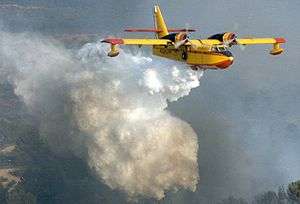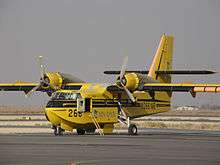Canadair CL-215
| CL-215 | |
|---|---|
 | |
| Role | Firefighting amphibious aircraft |
| Manufacturer | Canadair |
| First flight | 23 October 1967 |
| Introduction | 1969 |
| Status | Production completed |
| Primary users | Canada Greece Spain |
| Produced | 1969–1990 |
| Number built | 125 |
| Variants | Canadair CL-415 |

The Canadair CL-215 (Scooper) was the first model in a series of firefighting flying boat amphibious aircraft built by Canadair and later Bombardier. The CL-215 is a twin-engine, high-wing aircraft designed to operate well at low speeds and in high gust-loading environments, as are found over forest fires.
Design and development

The CL-215 can be traced back to two early projects by Canadair, the CL-43 and CL-204. The CL-43 was conceived as a logistics aircraft and was based on the design of the Canadian Vickers-built 369 Canso (a variant of the Consolidated PBY Catalina).[1] Arising from an earlier 1960s research study at the company, the original concept was for a twin-engined floatplane transport, that was altered into a "firefighter" as a result of a request by forestry officials in the Quebec Service Aérien (Quebec Government Air Service) for a more effective way of delivering water to forest fires. The 1962 preliminary design, the CL-204, was a purpose-designed water bomber that evolved into an amphibian flying boat configuration, powered by two shoulder-mounted 2,100 hp (1,566 kW) Pratt & Whitney R-2800 piston engines. The definitive design known as the CL-215 received a program go-ahead in February 1966 with its maiden flight on 23 October 1967.[2] The first delivery was to the French civil protection agency (Sécurité Civile, then known as Protection Civile) in June 1969. Production of CL-215s progressed through five series ending in 1990.
Variants
In 1987, the CL-215T was announced, with improvements in handling brought about by design changes to the wings and empennage, and more powerful Pratt & Whitney turboprop engines. Originally the follow-up CL-215T was to be a simple turboprop-powered development of the CL-215, and Canadair converted two aircraft in 1989 to act as development aircraft. The first of these flew on 8 June 1989. Retrofit kits for CL-215s to the new standard are offered, but Canadair elected not to build new CL-215Ts and instead developed the CL-415.
Cascade Aerospace, Canada, offers CL-215 to CL-215T engine retrofits using the Bombardier kit and Pratt & Whitney Canada PW123AF engines and is currently the only conversion kit installer in the world.[3]
Operators


Over a period of 21 years beginning in 1969, 125 of these aircraft were built and sold to customers in 11 countries.
As of January 2016 there were 59 CL215 registered with Transport Canada.[4]
- Buffalo Airways, Yellowknife, Northwest Territories: eight CL215 1A10
- Conair Group, Abbotsford, British Columbia: four CL-215-6B11 (Series CL-215T) (operated under contract on behalf of the aircraft owner - the Government of Alberta)
- Manitoba (Government) Air Service: eleven total, seven CL215 1A10; four CL-215-6B11 (Series CL-415)
- Government of Newfoundland and Labrador: seven total, two CL215 1A10; five CL-215-6B11 (Series CL-415)
- Ministry of Natural Resources and Forestry, Ontario: nine CL-215-6B11 (Series CL-415)
- Ministry of Natural Resources and Wildlife, Quebec: fourteen total, four CL215 1A10; two CL-215-6B11 (Series CL-215T); eight CL-215-6B11 (Series CL-415)
- Ministry of Environment Aviation Operations, Saskatchewan: six total, three CL215 1A10; three CL-215-6B11 (Series CL-215T); according to the Ministry of Environment six CL-215P deployed to Airtanker Groups 3, 4 and 5[5]
- Hellenic Air Force, 355 MTM: 21 CL-215s[6]
- Societa Ricerche Esperienze Meteorologiche (SoREM): five CL-215s leased abroad[7] and operated on behalf of Protezione Civile
- Spanish Air Force, 43 Grupo[8]
- Ministry of Environment (INAER): five Ex-Spanish Air Force CL-215Ts[9]
- Royal Thai Navy: one[10] of the two CL-215s delivered in 1978 is used for search and rescue/patrol.[11]
- Gokcen Aviation - Turkish Aeronautical Association: nine CL-215s and the current contractor for the Turkish Ministry of Forestry [12]
- Aero-Flite, Inc. Kingman, Arizona: five CL-215s[13]
Former operators
- 885th Firefighting Squadron of the Croatian Air Force and Air Defence operated CL-215s from 1991 to 2003. They have been replaced by CL-415s.[14]
- Sécurité Civile: 15 aircraft operated from June 1969 to 1996, now all replaced with 12 CL-415s.[15]
- CVG Ferrominera Orinoco: two CL-215s, one crashed on 1989, the other one has been parked ever since[16]
- Yugoslav Air Force: five CL-215s in service with the 676th Fire Fighting Squadron from 1981, until four sold to Greece in 1995.[17]
Accidents and incidents
CL-215s have been involved in 30 accidents, 19 fatal.[18]
Aircraft on display
- Canadian Bushplane Heritage Centre CL-215 F-ZBBT, formerly of the French Sécurité Civile[19][20]
- Musée de l'Air CL-215 F-ZBAY, formerly of the French Sécurité Civile[19]
- Sinsheim Auto & Technik Museum CL-215 F-ZBBH, formerly of the French Sécurité Civile[19]
- Technik Museum Speyer CL-215 F-ZBAR, formerly of the French Sécurité Civile[19]
Specifications (CL-215)


Data from Jane's All the World's Aircraft 1984–85[21]
General characteristics
- Crew: 2
- Capacity: Up to 26 forward facing seats for passenger transport
- Length: 19.82 m (65 ft 0 in)
- Wingspan: 28.6 m (93 ft 10 in)
- Height: 8.92 m (29 ft 3 in)
- Wing area: 100.33 m2 (1,079.9 sq ft)
- Aspect ratio: 8.15
- Empty weight: 12,160 kg (26,808 lb)
- Max takeoff weight: 19,731 kg (43,499 lb) on land, 17,100 kg (37,700 lb) on water
- Fuel capacity: 5,910 l (1,561.3 US gal; 1,300.0 imp gal) in two fuel tanks, of eight cells each, in the wings
- Powerplant: 2 × Pratt & Whitney R-2800-83AM 18-cyl air-cooled radial piston engines, 1,566 kW (2,100 hp) each
- Propellers: 3-bladed Hamilton Standard Hydromatic constant-speed fully-feathering propeller
Performance
- Cruising speed: 291 km/h (181 mph; 157 kn) at 18,595 kg (40,995 lb) and 3,050 m (10,010 ft)
- Stall speed: 123 km/h (76 mph; 66 kn) 25° flap power off at 15,603 kg (34,399 lb)
- Range: 2,094 km (1,301 mi; 1,131 nmi) with 1,587 kg (3,499 lb) payload at long-range cruise power
- Rate of climb: 5.0833 m/s (1,000.65 ft/min)
Avionics
- Dual VHF and VHF/FM comms,
- VOR/ILS receivers
- ADF
- Marker Beacon Rx
- Transponder
See also
- Related development
- Aircraft of comparable role, configuration and era
References
Notes
- ↑ "Canadair C.L.204." Secretprojects.co.uk. Retrieved: 26 April 2012.
- ↑ Taylor 1976, p.17.
- ↑ "Aerial Fire Control." Cascade Aerospace. Retrieved: 23 May 2012.
- ↑ "Canadian Civil Aircraft Register: Quick Search Result for CL215". Retrieved 2016-01-16.
- ↑ "Canadair CL-215 - Environment". Government of Saskatchewan (=Environment.gov.sk.ca ). Retrieved: 14 July 2014.
- ↑ Hoyle Flight International 13–19 December 2011, p. 39.
- ↑ Keijsper 2008, p. 42.
- ↑ "Canadair CL-215 T (UD.13T)." Ejército del aire. Retrieved: 8 January 2012.
- ↑ Keijsper 2008, p. 43.
- ↑ Hoyle Flight International 13–19 December 2011, p. 49.
- ↑ Air InternationalOctober 1978, p. 188.
- ↑ "Turkey's Single Airborne Fire Fighting Fleet". Gokcen Aviation, 2013. Retrieved: 14 July 2014.>
- ↑ "Our Equipment | Aero-Flite,Inc.Aero-Flite,Inc." Aerofliteinc.com. Retrieved: 14 July 2014.
- ↑ "Canadair 215." worldmilitair.com. Retrieved: 25 August 2013.
- ↑ Keijsper 2008, pp. 40–41.
- ↑ "ASN Aircraft accident: Canadair CL-215-1A10, YV-O-INC-2, Puerto Ordaz." Aviation-safety.net. Retrieved: 26 April 2012.
- ↑ Keijsper 2008, p. 44.
- ↑ "Canadair CL-215 Accident database". Aviation Safety Network. Retrieved: 29 June 2016.
- 1 2 3 4 Gabriel, Olivier. "Canadair CL-215 Bombardier d'eau" (in French). Netpompiers.fr. Retrieved: 23 May 2012.
- ↑ "Canadair CL-215". Canadian Bushplane Heritage Centre, 2012. Retrieved: 23 May 2012.
- ↑ Taylor, John W. R., ed. (1984). Jane's all the World's Aircraft 1984–85 (75th ed.). London: Jane's Publishing Co. pp. 22–23. ISBN 0-7106-0801-2.
Bibliography
- Hoyle, Craig. "World Air Forces Directory". Flight International, Vol. 180, No. 5231, 13–19 December 2011, pp. 26–52. ISSN 0015-3710.
- Keijsper, Gerard. "Water-Bombers Required!" Air Forces Monthly, London: Key Publishing, July 2008.
- Marsaly, Frederic and Samuel Pretat. "Bombardiers d'eau/ Canadair Scoopers." Editions Minimonde76, May 2012. ISBN 978-2-9541818-0-6.
- Pickler, Ron and Larry Milberry. Canadair: The First 50 Years. Toronto: CANAV Books, 1995. ISBN 0-921022-07-7.
- Taylor, John W. R. (editor). Jane's All the World's Aircraft 1976–77. London: Jane's Yearbooks, 1976. ISBN 0-354-00538-3.
- "Thai Boats". Air International, Vol. 15, No 4, October 1978, pp. 188–189.
External links
| Wikimedia Commons has media related to Canadair CL-215. |
- Gokcen Aviation
- Panhellenic Association of Families Lost in Action Aviators
- Snopes.com on the urban legend
- Airliners.net The Canadair CL-215 & 415
- North Carolina Division of Forest Resources Aviation Resources